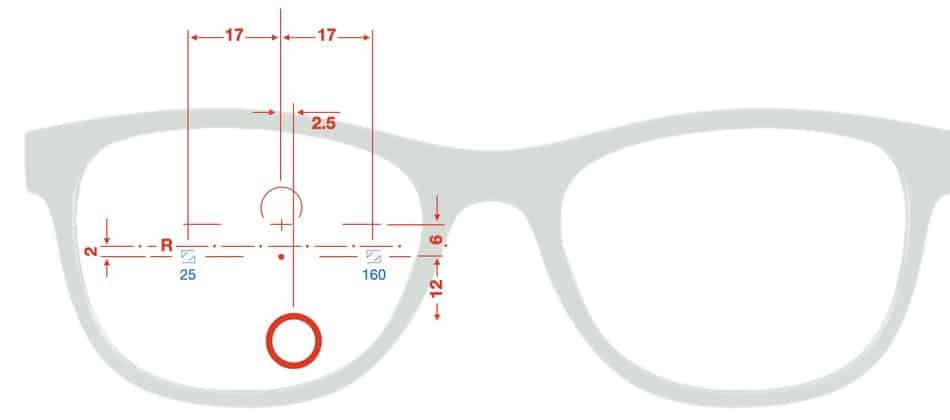Laser engravings in modern lenses are there to assess the centering of the lens in the glasses. Especially in progressive lenses, several engravings are placed in the lens by the manufacturer to provide the following information.
- Position of the lens vertically
- Position of the lens horizontally
- Axis position of the lens
- Manufacturer
- Material
- Type of progressive lens
- Strength of near addition ADD value
All this information can be found by looking closely at the engravings. You can see the engravings if you hold the lenses against the light. With some manufacturers, the engravings are more pronounced than with others. However, the position of the engravings is standardized.
Both engravings in the horizontal are 34mm apart. These engravings are illustrated again for you below in the picture. With the help of these engravings, the optician can determine where the fields of vision for distance, intermediate, and near are located and whether the progressive lens is optimally positioned in front of your eye.

The optician simply marks the horizontally arranged markings with a water-soluble pen. These can then be placed over a template and the other points, such as the through-vision point for distance or the position of the reading part, then become visible.
In this way, the optician can also determine optimal measurement points to check the prescription value of the progressive lenses. Often you can also discover typical logos in the engravings that are tied to a particular lens design at a manufacturer.
For example, Zeiss progressive lenses have the Z engraved in different variations depending on the type of progressive lens you have purchased. Similarly, Varilux progressive lenses, while other manufacturers such as Rodenstock rather rely on geometric shapes to be able to distinguish the lenses from each other with the engravings.
What Do the Markings on My Progressive Lenses Mean?
In the picture below you can see the information the optician gets from the laser engravings in your progressive lenses and a template. The engravings you see are marked here in blue while the information added by the template is marked in red.

To better understand the engravings in the progressive lens, I will give examples of the different engravings. When you look at the engravings, they should be at the same height inside a lens. If this is not the case, the lens is rotated.
This leads to incorrect centration and is very easy to check. With the help of the symbol in the engraving, the optician can quickly see which progressive lens from which manufacturer is in front of him. As shown in the example below using Rodenstock lenses. This means you should be able to see the same symbol towards your nasal side and your temporal side.

In some cases, the symbol also indicates the material used to manufacture the progressive lens. If this is not the case, you will find a number below the symbol, which usually consists of three digits. For example, 160, which is the material with a refractive index of 1.6. Alternatively, the following numbers could be engraved on the lens.
- 1.5
- 1.59
- 1.60
- 1.67
- 1.74
If the optician needs to repair your glasses he can immediately judge what he can and cannot do with the lenses. For example, some lenses need to be dry ground, such as lenses made of polycarbonate, which has a refractive index of 1.59.
On the opposite side, you will see a different number below the symbol. In our example, it was 25. In general, however, you could find the following engravings: …15, 17, 20, 22, 25, 27, 30, 32…
These engravings describe how strong the near addition that your progressive lens has been incorporated. This is also known as Add value. Most people need an Add value of about 2 D when they are over 50 years old. The higher this is, the narrower the sharp areas in the reading area of the progressive lens become.
What the Markings in the Progressive Lenses Don’t Tell You?
Although the optician knows which lens has been used, he cannot say exactly whether all parameters have been included in the calculation of the lens, because the changes are so minimal.
An example: Before progressive lenses are manufactured, the exact fit of the glasses is adjusted and the values are measured by your optician. One of these factors is, for example, how much the lens is tilted in front of your eye. Or how far away the lens is from your eye.
If now an individual progressive lens was ordered and all parameters are included in the calculations or one or the other parameter was not taken into account can not be traced with the help of the engravings. Since the manufacturer will use a standard parameter for the production in the case of a missing parameter.
Markings and Etchings Without Useful Information
There are also engravings that are applied to the lens simply for branding reasons. In the pictures below you can find some of them. These markings are really just there to present the logo of a company. However, it does not convey any technical information as is the case with the other engravings.

For the producers of progressive lenses, these engravings naturally lead to higher brand recognition. I personally find these logos on the lens rather annoying because they are too small to be really recognized. But someone sitting across from you sees them as a reflection, which is why I have often been asked if I have a scratch on the surface of my lens.
But these are minor things that bother me less in everyday life. Especially because these logos are not in the field of view. What can be annoying, however, is when the engravings are quite visibly lasered into the lens by the manufacturer. Here often only the change to another manufacturer or to another lens design helps to solve the problem of the too strongly noticeable engravings.
